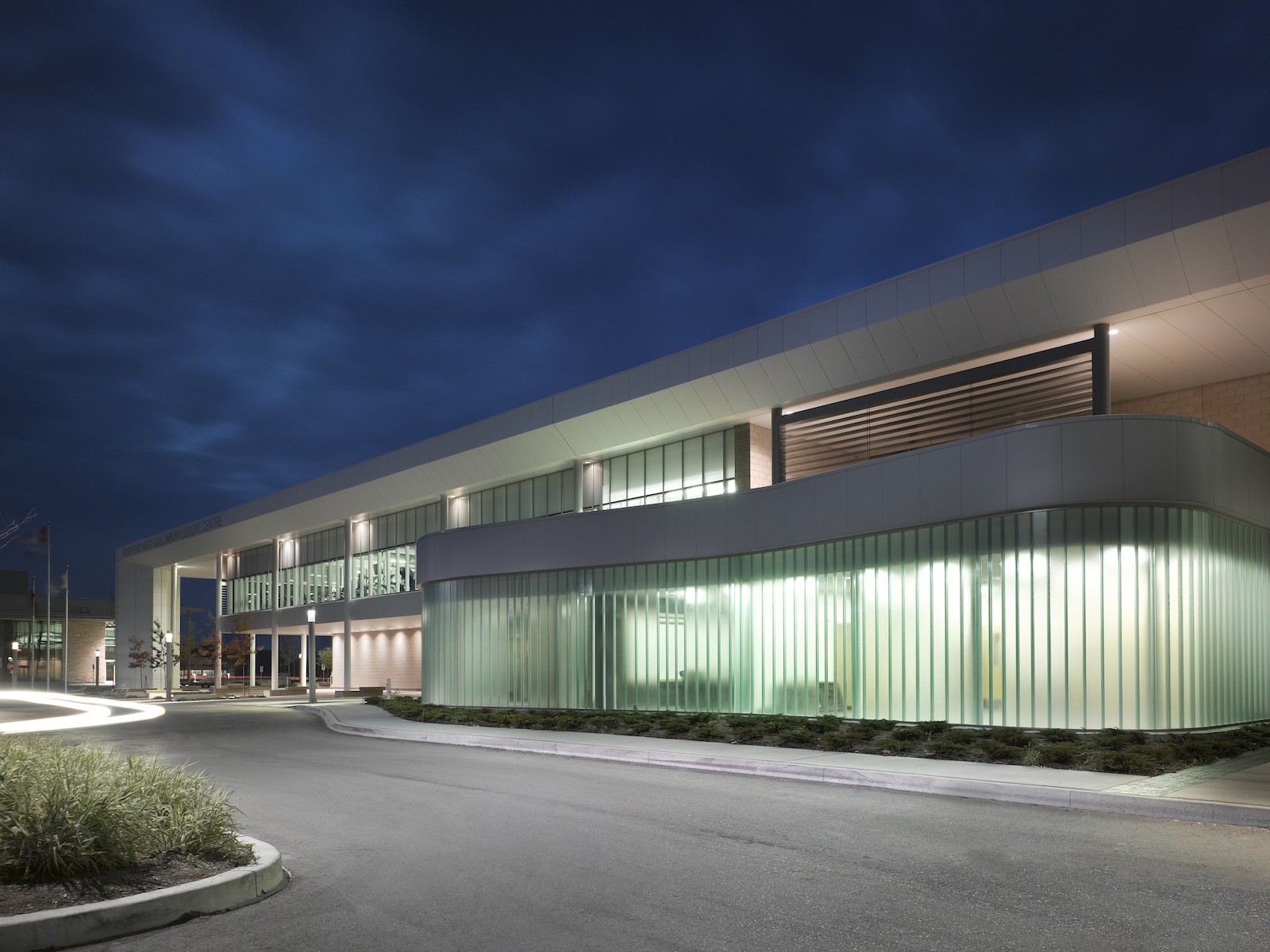Project: Bradford West Gwillimbury Leisure Centre
Location: Ontario, Canada
Architect: Salter Pilon Architecture in association with Lett Architects
Glazing Contractor: Aeroloc Industries
Channel Glass Supplier: Technical Glass Products
Glass Style: Pilkington Profilit™ channel glass; low-e tempered Pilkington Profilit channel glass
Ontario's new Bradford West Gwillimbury Leisure Centre, designed by Salter Pilon Architecture, is one of the largest multi-use recreation facilities in the province. However, it does more than foster a healthy lifestyle through recreational and cultural activities. Its 1,400-sf serpentine channel glass wall delivers dramatic visual appeal for residents—one of the town's three core visions for the new facility.
To create the curving glass façade, the design team turned to Pilkington Profilit™ channel glass. Unlike conventional windows and glass block, its slender frames and narrow channel glass segments allow for tight radii—as low as 1.9 meters (78 in.). While this flexibility enabled the design team to create a serpentine configuration, one technical challenge was ensuring a homogenous appearance in areas of the facade with different radii. Channel glass segments tangent to one another flow smoothly into adjacent curves or straight sections. Creating a seamless transition is more complex where different radii prevent tangent segments.
To ensure the U-shaped channel glass system did not interfere with the joint connection and interrupt the channel glass wall’s uniform look, flanged L-shaped channel glass planks were installed on one side of the joint transition and full U-shaped channel glass planks on the opposing side. This configuration allowed the channel glass framing head and sill components to be stretch-formed into a smooth continuous structure with a precise radius.
The serpentine channel glass application is formed of a mixture of standard cast glass and clear channel glass. The standard cast glass diffuses light through its textured surface while also obscuring vision. Clear cast glass adds a second layer of visual interest and provides occupants with greater access to daylight and views to nature. This glazing combination helps the system meet the different light transfer, privacy and visibility needs of the various rooms it encloses. A low-emissivity coating further boosts the façade’s thermal performance.
The completed façade flanks the Bradford West Gwillimbury Leisure Centre’s east exterior wall. It breaks up the building’s rectangular shape and serves as a surround for a lobby, meeting room and multipurpose room. By day it transmits light into the leisure centre’s interior rooms. By night, its backlit form helps welcome people inside.
TGP’s Pilkington Profilit channel glass soars up to 23 feet, can be installed vertically or horizontally, and formed into straight or curved walls. It is available in a variety of textures and colors with varying degrees of translucency, allowing light through while maintaining privacy. Pilkington Profilit can be used in interior or exterior applications, with insulating Lumira® aerogel for superior energy efficiency.
For more information on Pilkington Profilit channel glass, along with TGP’s other specialty architectural glazing materials, visit www.tgpamerica.com.
Technical Glass Products
800.426.0279
800.451.9857 – fax
sales@fireglass.com
www.fireglass.com
Related Stories
| Jun 27, 2013
Thermal, solar control designs can impact cooling loads by 200%, heating loads by 30%
Underestimating thermal bridging can greatly undermine a building’s performance contributing to heating load variances of up to 30% and cooling load variances of up to 200%, says the MMM Group.
| May 17, 2013
5 things AEC pros need to know about low-e glass
Low-emissivity glasses are critical to making today’s buildings brighter, more energy-efficient, and more sustainable. Here are five tips to help AEC professionals understand the differences among low-e glasses and their impact on building performance.
| May 14, 2013
Easy net-zero energy buildings [infographic]
"Be a Zero Hero" infographic educates building industry professionals on ultra energy-efficient structural insulated panel construction
| May 8, 2013
Preventable curtain wall failures - AIA/CES course
In many cases, curtain wall failures are caused by fairly simple errors that occur during the fabrication and installation process. This presentation will highlight common errors and when they typically occur.
| Apr 16, 2013
5 projects that profited from insulated metal panels
From an orchid-shaped visitor center to California’s largest public works project, each of these projects benefited from IMP technology.
| Apr 10, 2013
23 things you need to know about charter schools
Charter schools are growing like Topsy. But don’t jump on board unless you know what you’re getting into.
| Apr 8, 2013
Oldcastle Architectural acquires Expocrete Concrete Products
Oldcastle® Architectural has acquired Expocrete Concrete Products Ltd., giving North America’s largest producer of concrete masonry and hardscape products an increased presence in the high-growth region of western Canada.
| Apr 3, 2013
AIA CES class: Sealant repairs that last – hybrid sealants for building restoration
It is hard to talk about restoration without talking about sustainability. This two-hour interactive online course discusses the role that restoration can and does play in the arena of sustainability, and specifically the role that sealants play in sustainable design and repair.
















